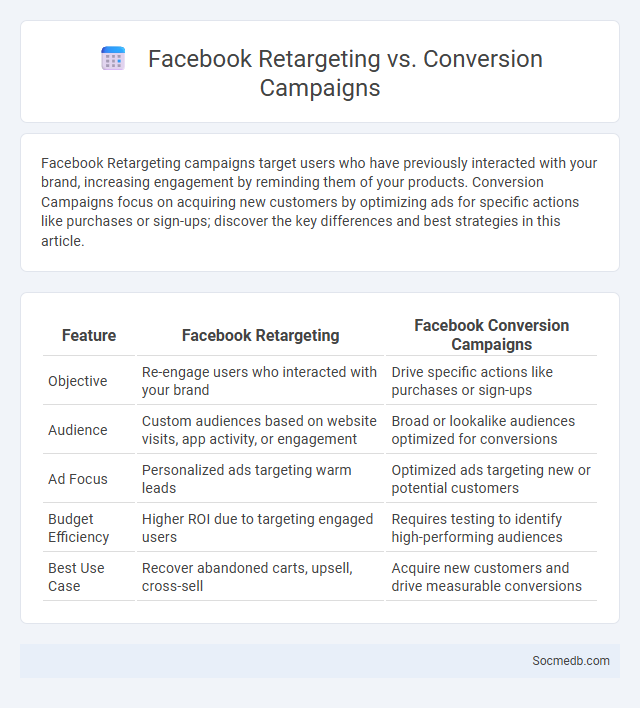
Photo illustration: Facebook Retargeting vs Conversion Campaigns
Facebook Retargeting campaigns target users who have previously interacted with your brand, increasing engagement by reminding them of your products. Conversion Campaigns focus on acquiring new customers by optimizing ads for specific actions like purchases or sign-ups; discover the key differences and best strategies in this article.
Table of Comparison
| Feature | Facebook Retargeting | Facebook Conversion Campaigns |
|---|---|---|
| Objective | Re-engage users who interacted with your brand | Drive specific actions like purchases or sign-ups |
| Audience | Custom audiences based on website visits, app activity, or engagement | Broad or lookalike audiences optimized for conversions |
| Ad Focus | Personalized ads targeting warm leads | Optimized ads targeting new or potential customers |
| Budget Efficiency | Higher ROI due to targeting engaged users | Requires testing to identify high-performing audiences |
| Best Use Case | Recover abandoned carts, upsell, cross-sell | Acquire new customers and drive measurable conversions |
Introduction to Facebook Advertising Strategies
Facebook advertising strategies leverage targeted audience segmentation to maximize engagement and conversion rates. Utilizing Facebook Ads Manager allows marketers to create customized campaigns based on user demographics, interests, and behaviors, improving ad relevance and return on investment. Effective strategies include A/B testing creatives, optimizing bidding methods, and using retargeting to capture potential customers.
What is Facebook Retargeting?
Facebook Retargeting is a powerful digital marketing strategy that targets users who have previously interacted with a brand's website or mobile app but did not complete a desired action, such as making a purchase. By utilizing Facebook Pixel, businesses can track user behavior and deliver highly personalized ads to re-engage potential customers, increasing the likelihood of conversion. This technique enhances ad relevancy and optimizes advertising spend by focusing on an audience already interested in the product or service.
Understanding Facebook Conversion Campaigns
Facebook conversion campaigns are designed to drive specific actions such as purchases, sign-ups, or app installs by targeting users most likely to convert. Utilizing Facebook Pixel allows advertisers to track user behavior, optimize ad delivery, and measure campaign performance with precise attribution. Leveraging Custom Audiences and Lookalike Audiences helps in reaching high-intent users, maximizing return on ad spend (ROAS) for businesses.
Key Differences Between Retargeting and Conversion Campaigns
Retargeting campaigns concentrate on engaging users who have previously interacted with Your brand, using personalized ads to bring them back and boost conversion chances. Conversion campaigns focus on attracting new audiences with the intent to drive specific actions such as purchases, sign-ups, or downloads, optimizing ad delivery based on conversion data. Understanding these key differences can help You allocate budget effectively and tailor strategies to maximize ROI on social media platforms.
When to Use Facebook Retargeting
Facebook retargeting is most effective when Your audience has already interacted with Your website or content, indicating a higher interest level. Use this strategy after a visitor abandons a shopping cart, visits specific product pages, or engages with Your brand through video views or lead forms. Timing Your retargeting campaigns within days of the initial interaction maximizes conversion rates by keeping Your brand top-of-mind.
When to Choose Conversion Campaigns
Conversion campaigns are ideal when the primary goal is to drive specific actions such as purchases, sign-ups, or lead generation. These campaigns maximize return on ad spend by targeting users who are most likely to complete desired conversions based on data-driven audience insights. Choosing conversion campaigns is essential when tracking measurable outcomes and optimizing for high-intent customer behaviors in social media marketing.
Audience Targeting: Retargeting vs Conversion
Audience targeting in social media marketing enhances your campaign effectiveness by using retargeting to re-engage users who previously interacted with your content, increasing brand recall and potential conversion rates. Conversion-focused targeting directs ads toward users most likely to complete a desired action, such as purchasing or signing up, based on behaviors and demographic data. Your marketing success improves significantly when leveraging both retargeting strategies and precise conversion targeting to maximize ROI and customer acquisition.
Ad Creative and Messaging Strategies
Crafting compelling ad creative is essential for capturing attention and driving engagement on social media platforms. Your messaging strategy should align with audience demographics, utilizing clear, concise language and strong calls-to-action to maximize conversion rates. Testing and refining visuals and copy based on performance metrics helps optimize your campaign's overall impact and reach.
Measuring Success: KPIs and Metrics
Tracking key performance indicators (KPIs) such as engagement rate, click-through rate, and follower growth is essential for measuring social media success. Monitoring metrics like impressions, reach, and conversion rates helps you understand the impact of your content and campaigns. Using these insights allows you to optimize strategies and improve your overall social media performance.
Choosing the Right Campaign for Your Goals
Selecting the right social media campaign hinges on clearly defining your marketing objectives, such as brand awareness, lead generation, or sales conversion. Platforms like Facebook, Instagram, LinkedIn, and Twitter offer distinct ad formats and targeting options that align differently with campaign goals. Leveraging data analytics and audience insights helps tailor the campaign strategy to maximize engagement and return on investment.
 socmedb.com
socmedb.com